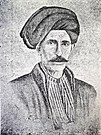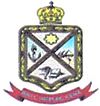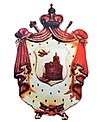
A | B | C | D | E | F | G | H | CH | I | J | K | L | M | N | O | P | Q | R | S | T | U | V | W | X | Y | Z | 0 | 1 | 2 | 3 | 4 | 5 | 6 | 7 | 8 | 9
ﺍﻟْﻤَﺴِﻴﺤِﻴُّﻮﻥ ﺍﻟْﻌَﺮَﺏ | |
|---|---|
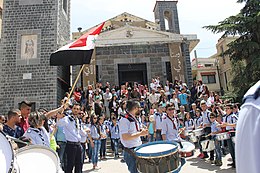 Greek Orthodox Easter in As-Suwayda, Syria | |
| Total population | |
| 10–15+ million[1] | |
| Regions with significant populations | |
| 1,200,000[2] | |
| 1,150,000–1,200,000[3][4] | |
| 250,000–400,000[5] | |
| 133,130[6] | |
| 100,000 excluding 500,000 Copts[7] | |
| 50,000[4] excluding 1,500,000 Assyrians[8] | |
| 50,000[9] excluding disputed territories | |
| 45,000–380,000[10] | |
| 40,000[11]–150,000[12] | |
| 23,500[13] | |
| 18,000[14] | |
| 10,000[15]–350,000[4] excluding 6–10 million Copts[16][17] | |
| 1,500[18] | |
| 1,000[19] | |
| 400[20] | |
| 259–400[21] | |
| Languages | |
| Arabic Liturgical: Koine Greek, Latin, Syriac, Classical Arabic | |
| Religion | |
| Greek Orthodox Church Catholic Church Oriental Orthodox Church Protestantism | |
| Related ethnic groups | |
[22][23] | |
Arab Christians (Arabic: ﺍﻟْﻤَﺴِﻴﺤِﻴُّﻮﻥ ﺍﻟْﻌَﺮَﺏ, romanized: al-Masīḥiyyūn al-ʿArab) are ethnic Arabs, Arab nationals, or Arabic speakers who follow Christianity. The number of Arab Christians who live in the Middle East was estimated in 2012 to be between 10 and 15 million.[1] Arab Christian communities can be found throughout the Arab world, but are concentrated in the Eastern Mediterranean region of the Levant and Egypt, with smaller communities present throughout the Arabian Peninsula and North Africa.
The history of Arab Christians coincides with the history of Eastern Christianity and the history of the Arabic language; Arab Christian communities either result from pre-existing Christian communities adopting the Arabic language, or from pre-existing Arabic-speaking communities adopting Christianity. The jurisdictions of three of the five patriarchates of the Pentarchy primarily became Arabic-speaking after the early Muslim conquests – the Church of Alexandria, the Church of Antioch and the Church of Jerusalem – and over time many of their adherents adopted the Arabic language and culture.[24] Separately, a number of early Arab kingdoms and tribes adopted Christianity, including the Nabataeans, Lakhmids, Salihids, Tanukhids, ʿIbādī of al-Hira, and the Ghassanids.
In modern times, Arab Christians have played important roles in the Nahda movement, and they have significantly influenced and contributed to the fields of literature, politics,[25] business,[25] philosophy,[26] music, theatre and cinema,[27] medicine,[28] and science.[29] Today Arab Christians still play important roles in the Arab world, and are relatively wealthy, well educated, and politically moderate.[30] Emigrants from Arab Christian communities also make up a significant proportion of the Middle Eastern diaspora, with sizable population concentrations across the Americas, most notably in Brazil, Argentina, Venezuela, Colombia, and the US. However those emigrants to the Americas, especially from the first wave of emigration, have often not passed the Arabic language to their descendants.[31]
The concept of an Arab Christian identity remains contentious, with some Arabic-speaking Christian groups in the Middle East, such as Assyrians, Armenians, Greeks and others, rejecting an Arab identity. Individuals from Egypt's Coptic community and Lebanon's Maronite community sometimes assume a non-Arab identity.[32][33]
History
The history of Arab Christians coincides with the history of Christianity and the history of the Arabic language; Arab Christian communities result either from pre-existing Christian communities adopting the Arabic language, or from pre-existing Arabic-speaking communities adopting Christianity. Arab Christians include the indigenous Christian communities of Western Asia who became majority Arabic-speaking after the consequent seventh-century Muslim conquests in the Fertile Crescent.[34] The Christian Arab presence predates the early Muslim conquests, and there were many Arab tribes that converted to Christianity, beginning in the 1st century.[35]
The interests of the Arabs before the 9th century A.D. were focused primarily on the recording and translating of pre-Islamic poetry. The early Arab Christians recorded Syriac hymns, Arabic poetry, ecclesiastical melodies, proverbs, and ḥikam (rules of governance).[36] They did not otherwise record religion, which gave way to conflicting accounts and sparse evidence for specific practices over several centuries.[37]
From classical antiquity to modern times, Arab Christians have played important roles contributing to the culture of the Mashriq, in particular those in the Levant, Egypt and Iraq.
Pre-Islamic period
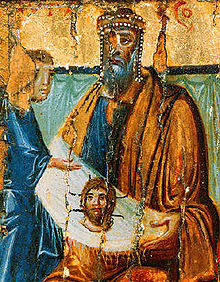
The New Testament has a biblical account of Arab conversion to Christianity recorded in the Book of Acts. When Saint Peter preaches to the people of Jerusalem, they ask,
And how hear we every man in our own tongue, wherein we were born?
Arabians, we do hear them speak in our tongues the wonderful works of God. (Acts 2:8, 11 KJV)
The first mention of Christianity in Arabia occurs in the New Testament as the Apostle Paul references his journey to Arabia following his conversion (Galatians 1: 15–17). Later, Eusebius discusses a bishop named Beryllus in the see of Bostra, the site of a synod c. 240 AD and two Councils of Arabia.[38] The New Testament signals an early entry of Christianity among the Arabs; in addition to what was narrated by al-Tabari, Abu al-Fida, al-Maqrizi, Ibn Khaldun and al-Masoudi, the disciples of Christ (including Matthew, Bartholomew and Thaddeus)[39] were the ones who went to Arabia as preachers of the religion. Sozomen of Gaza said that the Arabs converted to Christianity through the efforts of priests and monks who spread to Arab regions, and the strength of Christianity increased with the conversion of the major tribes. The religion was organised in many dioceses controlled by bishops and archbishops. The Arab bishops were divided into types: urban bishops residing in cities, and “tent bishops” who resided in tents and moved with their tribes from one place to another. The number of Arab bishops among the Nabataeans alone reached forty according to Ibn Duraid.[40][41] The first Arab bishop of the Arabs, Saint Moses, spent many years in the 4th century as a hermit between Syria and Egypt.[42] His piety impressed Mavia, Arab warrior-queen of the Tanukhids, and she made his consecration as a bishop over her people a condition to any truce with Rome.[43]
The Jordan Valley and the Balqa was under Arab Christian rule by the second century AD. The Nabataeans, natives of the southern Levant, also converted to Christianity in the Late Roman Period. In Palmyra and near al-Qaryatayn there are Christian monuments and the remains of churches and inscriptions that indicate the spread of the religion into Syria proper.[44][45] The administration of Jordan under Roman rule was given to the Quda'a tribe. This tribe had embraced Christianity according to Ya'qubi, and were later succeeded by the Christian Salihids and Ghassanid Kingdom.[46][47] There are poetic verses by the pre-Islamic poet al-Nabigha in which he praises the kings of Ghassan, congratulating them on Palm Sunday. Bordering Syria, the Sinai was administratively affiliated with the Egyptian Church based in Alexandria. There are documents from the late third century of Dionysius, Pope of Alexandria, in which he mentions his Arab Christian subjects in the Sinai and the persecution they faced during the days of the pagan Roman emperor Diocletian.[48][49] Later, forty martyrs fell in 309 in Mount Sinai during a raid by pagan Arabs on their hermitages. The monks fortified their new monasteries, and the most fortified is still in use today, Saint Catherine's Monastery, built by the commission of Roman emperor Justinian in 565. It has hosted a number of Church bishops and theologians, Ghassanid and Lakhmid kings, and pre-Islamic poets.[50]

The southern Arabian city of Najran was made famous by the religious persecution of Christians by one of the kings of Yemen, Dhu Nuwas, who was an enthusiastic convert to Judaism. The leader of the Arabs of Najran during the period, al-Ḥārith, was canonized by the Catholic Church as Arethas. Aretas was the leader of the Christians of Najran in the early 6th century and was executed during the massacre of Christians by the king in 523.[51] Ibn Khaldun, Ibn Hisham and Yaqut al-Hamawi mentioned that Najran was entirely Christian when Dhu al-Nawas converted to Judaism, and that the people of Najran refused to convert to his faith, so he massacred them. The victims were mentioned by Ibn Ishaq and named in the Quran as the "People of the Ditch".[52] The Byzantine emperor Justin I was enraged and encouraged Kaleb of Axum to occupy Yemen and eliminate the Jewish king. Dhu al-Nawas was later deposed and killed, prompting Kaleb to appoint a native Christian Himyarite, Sumyafa Ashwa, as his viceroy.[53] The Aksumites thus conquered Himyar and their rule lasted until 575. The Abyssinians spread Christianity and their rulers built an extravagant building in honor of the Martyrs of Najran. It was known by its contemporaries for its beauty, adorned with ornaments, jewels, and prominent archways. Arabs called it the “Kaaba of Najran”.[54] The Yemenis later rebelled against the Abyssinians and demanded independence.[55][56] History records Christian influence from Ethiopia to Arab lands in pre-Islamic times, and some Ethiopian Christians may have lived in Mecca.[57]

Yemen had an important share in ancient Christianity. In the second century, the Greek theologian Pantaenus left Alexandria and headed towards Yemen as a missionary after his conversion.[58] Historians such as Rufinus and Orosius mentioned that Matthew the Apostle was the missionary of Yemen and Abyssinia.[59] A special relationship developed between the people of Yemen and the Syrian Church, as inferred by the works of Ephrem the Syrian, the biography of Simeon Stylites, and the historian Philostorgius, who said that some villages and settlements established in Yemen were Syriac-speaking. The famous Al-Qalis Church in Sana'a was built to serve aderents and to attract pilgrims travelling to the Kaaba of Mecca and Ghamdan Palace.[60] On the organizational level, the Archbishop of Yemen held the title "Catholicos" which follows the "Patriarch" in rank.[61] The spread of Christianity amongst Arabs reached Upper Mesopotamia, where Banu Bakr and Banu Mudar lived, both famous for their staunch Christian beliefs and for honoring Sergius the Military Saint.[62] Ibn Khallikan mentioned that all the Yemeni Arabs in Iraq converted to Christianity, including Taym al-Lat, Kalb, Lakhm and Tanukh, and many had moved towards Bahrain by the fourth century.[63]
In Medina there was a Christian sect that was rejected by the official church and considered heretical. They deified the Virgin Mary and gave her offerings. This sect was mentioned by a number of historians, including Epiphanius and Ibn Taymiyyah, who called them "The Marians" (Al-Maryamiyyun). Likewise, al-Zamakhshari and al-Baydawi referred to this sect in their interpretation of the Qur’an.[64] Another sect called "The Davidians" (Al-Dāwudiyyūn) were known for their exaggerations in honoring King David. Some contemporary historians classified it as a Judeo-Christian heresy.[65] In Mecca, the Banu Jurhum embraced Christianity at the hands of their sixth king, Abd al-Masih ibn Baqia, and supervised the service of the Haram for a period of time.[66] Banu Azd and Banu Khuza’a became Christians with them according to Abu al-Faraj al-Isfahani.[67] The earliest indications of Christianity in Mecca is the Christian cemetery outside the Medina towards the well of 'Anbasa, confirmed by al-Maqdisi, as well as the conversion to Christianity by some members of the Quraish.[68]
Islamic Era
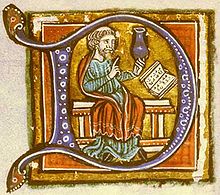

Following the fall of large portions of former Byzantine and Sasanian provinces to the Arab armies, a large indigenous Christian population of varying ethnicities came under Arab Muslim dominance. Historically, a number of minority Christian sects were persecuted as heretic under Byzantine rule (such as non-Chalcedonians). The Islamic conquests set forth two processes affecting these Christian communities: the process of Arabization, causing them gradually to adopt Arabic as a spoken, literary, and liturgical language (often alongside their ancestral tongues), and the much slower, yet persistent process of Islamization.[70] As Muslim army commanders expanded their empire and attacked countries in Asia, North Africa and southern Europe, they would offer three conditions to their enemies: convert to Islam, pay jizya (tax) every year, or face war to death. Those who refused war and refused to convert were deemed to have agreed to pay jizya.[71][72]
As "People of the Book", Christians in the region were accorded certain rights under Islamic law to practice their religion (including having Christian law used for rulings, settlements or sentences in court). In contrast to Muslims, who paid the zakat tax, they paid the jizya, an obligatory tax. The jizya was not levied on slaves, women, children, monks, the old, the sick, hermits, or the poor.[73] In return, non-Muslim citizens were permitted to practice their faith, to enjoy a measure of communal autonomy, to be entitled to Muslim state's protection from outside aggression, to be exempted from military service, and to be exempted from the zakat.[74][75] Like Arab Muslims, Arab Christians refer to God as "Allah".[76][77] As with the Christians of Malta, this practice is distinguished from the Islamic use of the word "Allah" which refers to the personal name of God in that faith.[78] The use of the term Allah in Arab churches predates Islam.[76]
During the Islamic Golden Age, Christians contributed to the Islamic civilization in various fields,[79][80] and the institution known as the House of Wisdom employed Christian scholars to translate works into Arabic and to develop new knowledge.[81]
Modern Era
Arab Christians have always been the go-between the Islamic world and the Christian West, mainly down to mutual religious affinity. The Greek Orthodox share Orthodox ties with Russia and Greece; whilst Melkites and Maronites share Catholic bonds with Italy, Vatican and France.[82] Scholars and intellectuals agree Christians in the Arab world have made significant contributions to Arab civilization since the introduction of Islam, and they have had a notable impact contributing the culture of the Mashriq.[83][82] Many Arab Christians today are physicians, entertainers, philosophers, government officials and people of literature.[25]
Academia
Arab Christians throughout history have been noted for their impact on academia and literature.[25][84] Arabic-speaking Christian scholars wrote extensive theological and philosophical works and treatises in Arabic in which they not only responded to the polemics of their Muslim adversaries,[85] but also provided systematic apologetic discussions of the Christian faith and practice.[86] Notable Lebanese academics in the modern era include Carmelite linguist Anastas al-Karmal, novelist Tawfiq Yusuf 'Awwad, and philologist Ibrahim al-Yaziji, whose Bible translations were among the first in the modern Arabic language. There are many New Testament translations or portions into regional colloquial forms of Arabic.[87] Noted Palestinian physician and ethnographer Tawfiq Canaan's academic work serves as valuable resources to researchers of Palestinian history.[88] Jordanian historian Suleiman Mousa was the only author to write about Lawrence of Arabia and show the Arab perspective. Mousa noted that were many books written to praise Lawrence, and all of them exaggerated his part in the Arab Revolt and failed to do justice to the Arabs themselves.[89] Syrian writers include scholar Francis Marrash and writer Hanna Mina, described in Literature from the "Axis of Evil" as the country's most prominent.[90]
Politics


Arab Christians were among the first Arab nationalists. As early as 1877, Maronite leader Youssef Bey Karam proposed to Emir Abdelkader the separation of the Arabic-speaking provinces from the Ottoman Empire using the terms al-gins al-'arabi ("Arab race") and gaba'il al-arabiya ("Arab tribes").[92][93] In the early 20th century, many prominent Arab nationalists were Christians, like the Syrian intellectual Constantin Zureiq,[94] Ba'athism proponent Michel Aflaq,[95] and Jurji Zaydan,[96] who was reputed to be the first Arab nationalist. Khalil al-Sakakini, a prominent Palestinian Jerusalemite, was Arab Orthodox, as was George Antonius, Lebanese author of The Arab Awakening.[97][98] Grégoire Haddad, known as the "Red Bishop of Beirut", founded the "Lebanese Social Movement" with Shiite Imam Musa al-Sadr in 1960, and promoted in the following years Islamic-Christian dialogue.[99][100] The first Syrian nationalists were also Christian. Although both Lebanese, Antoun Saadeh was the founder behind the Syrian Social Nationalist Party and Butrus al-Bustani is considered to be the first Syrian nationalist. Sa'adeh rejected Pan-Arabism and argued instead for the creation of a "United Syrian Nation" or "Natural Syria". George Habash, founder of the Popular Front for the Liberation of Palestine was Arab Orthodox, and so was Wadie Haddad, the leader of the PFLP's armed wing. Influential Palestinian Christians such as Tawfik Toubi, Daud Turki, Emile Touma and Emile Habibi became leaders of the Israeli and Palestinian communist party.[101] Nayif Hawatmeh is the founder and leader of the Democratic Front for the Liberation of Palestine, and Kamal Nasser and Hanan Ashrawi were members of the PLO Executive Committee.[102]
Media
Christians developed Arabic-speaking Christian media, including various newspapers, radio stations, and television networks such as Télé Lumière, Aghapy TV, CTV, and SAT-7, which is a Christian broadcasting network that was founded in 1995; it targets primarily Arab Christians in North Africa and the Middle East.[103] These media networks produce dozens of Arabic-language Christian films, musical works, as well as radio and television programmes.[103]
Syro-Lebanese Melkite Saleem Takla and his brother Beshara founded the Al-Ahram newspaper in 1875 in Alexandria; now the most widely circulated Egyptian daily newspaper.[104] Similarly, Lebanese Protestant Faris Nimr co-founded Al Muqattam in 1888, a leading Cairo-based newspaper in circulation until 1954. In Palestine, Najib Nassar's newspaper Al-Karmil was the first anti-Zionist weekly newspaper. It appeared in Haifa in 1908 and was shut down by the British in the 1940s.[105] Likewise, the Arab Orthodox El-Issa family from Jaffa founded the Falastin newspaper in 1911. The paper was Palestine's most consistent critic of the early Zionist movement. In Lebanon, the influential Greek Orthodox Tueni family founded the An-Nahar newspaper in 1933, also one of the leading newspapers today.[106][107] Shireen Abu Akleh worked as a reporter for the Arabic-language channel Al Jazeera for 25 years.
Popular Lebanese singer Fairuz has over 150 million records sold worldwide, making her the highest selling Middle-Eastern artist of all time.[108] Other Lebanese singers include Majida El Roumi, legendary folk veteran Wadih El Safi, 'Queen of Arab pop' Nancy Ajram, and Lydia Canaan.[109][110] Syrian notables include George Wassouf and Nassif Zeytoun.[111][112] Palestinians include Lina Makhul, Fadee Andrawos, and Israeli singer Mira Awad.[113][114]
Role in Al-Nahda
The Nahda (meaning "the Awakening" or "the Renaissance") was a cultural renaissance that began in the late 19th and early 20th centuries. It began in the wake of the exit of Muhammad Ali of Egypt from the Levant in 1840.[115] Beirut, Cairo, Damascus and Aleppo were the main centers of the renaissance and this led to the establishment of schools, universities, theater and printing presses. This awakening led to the emergence of a politically active movement known as the "association" that was accompanied by the birth of Arab nationalism and the demand for reformation in the Ottoman Empire. This led to the calling of the establishment of modern states based on Europe.[116] It was during this stage that the first compound of the Arabic language was introduced along with the printing of it in letters, and later the movement influenced the fields of music, sculpture, history, humanities, economics and human rights.
This cultural renaissance during the late Ottoman rule was a quantum leap for Arabs in the post-industrial revolution, and is not limited to the individual fields of cultural renaissance in the nineteenth century, as the Nahda only extended to include the spectrum of society and the fields as a whole. Christian colleges (accepting of all faiths) like Saint Joseph University, American University of Beirut (Syrian Protestant College until 1920) and Al-Hikma University in Baghdad amongst others played a prominent role in the development of Arab culture.[117] It is agreed amongst historians the importance the roles played by the Arab Christians in this renaissance, and their role in the prosperity through participation in the diaspora.[118][25] Given this role in politics and culture, Ottoman ministers began to include them in their governments. In the economic sphere, a number of Christian families like the Greek Orthodox Sursock family became prominent. Thus, the Nahda led the Muslims and Christians to a cultural renaissance and national general despotism. This solidified Arab Christians as one of the pillars of the region and not a minority on the fringes.[119]
- Notable Arab Christians of al-Nahda
-
Mary Ajami
(1888–1965)
was a Syrian writer who launched the first women's newspaper in the Middle East[120] -
Qustaki al-Himsi
(1858–1941)
was a Syrian intellectual who was the founder of modern Arabic literary criticism -
Maryana Marrash
(1849–1919)
was a writer, poet and the first Syrian woman to publish a collection of poetry
Religious Persecution
The Massacre of Aleppo of 1850 often referred to simply as The Events was a riot perpetrated by Muslim residents of Aleppo, largely from the eastern quarters of the city, against Christian residents, largely located in the northern suburbs of the predominantly Christian neighbourhood Judayde (Jdeideh) and Salibeh. The Events are considered by historians to be particularly important in Aleppian history, for they represent the first time disturbances pitted Muslims against Christians in the region. The patriarch of the Syriac Catholic Church Peter VII Jarweh was fatally wounded in the attacks and died a year later. 20–70 people died from rioting and 5,000 died as a result of bombardment.[121]

The 1860 civil conflict in Mount Lebanon and Damascus was a civil conflict and later massacre during Ottoman rule, started by skirmishes occurring between the Maronites and the Druze of Mount Lebanon. Following decisive victories and massacres against Christians, the conflict spilled over into other parts of Ottoman Syria, particularly the city Damascus, where over ten thousand Christian residents of various denominations were killed by Druze and Muslim militiamen. With the connivance of the military authorities and Turkish soldiers, Druze and allied paramilitary groups organised pogroms in Damascus which lasted three days (9–11 July).[122] By the war's end, around 20,000 Christians had been killed, and many villages and churches were destroyed. The Christian quarter of old Damascus was destroyed and houses were plundered. Historian Mikhail Mishaqas' memoir of the massacre is valuable to historians, as it is the only account written by a survivor of a mob attack.[123] Emir Abdelkader al-Jazairi, the exiled Algerian Muslim military leader, ordered his sons and soldiers to protect and shelter Damascene Christians from impending interpersonal violence that was spreading throughout the city, thereby saving thousands, preserving this ancient community from complete devastation.[124][125]
Melkite Greek Catholic and Maronite Christians suffered negligence from the Ottoman authorities and a naval blockade from France and Britain, resulting in the Great Famine of Mount Lebanon (1915–1918) during World War I, which ran in conjunction with the Armenian genocide, the Assyrian genocide and the Greek genocide. The Mount Lebanon famine caused the highest fatality rate by population during World War I.[126] Around 200,000 people starved to death when the population of Mount Lebanon was estimated to be 400,000 people.[127] The Lebanese diaspora in Egypt funded the shipping of food supplies to Mount Lebanon, sent via the Syrian Island town of Arwad.[128] On 26 May 1916, Lebanese-American writer Khalil Gibran wrote a letter[126] to Mary Haskell that read:
"The famine in Mount Lebanon has been planned and instigated by the Turkish government. Already 80,000 have succumbed to starvation and thousands are dying every single day. The same process happened with the Christian Armenians and applied to the Christians in Mount Lebanon."
Regional Conflicts
During the 1948 Arab–Israeli War, a number of Palestinian Greek Orthodox and Melkite communities were ethnically cleansed and driven out of their towns, including al-Bassa, Ramla, Lod, Safed, Kafr Bir'im, Iqrit, Tarbikha, Eilabun and Haifa. Many Christian towns or neighborhoods were ethnically cleansed and destroyed during the period between 1948 and 1953. All the Christian residents of Safed, Beisan, Tiberias were removed, and a big percentage displaced in Haifa, Jaffa, Lydda and Ramleh.[129] Arab Christian Constantin Zureiq was the first to coin the term "Nakba" in reference to the 1948 Palestinian exodus.[130]
In 1975, the Lebanese Civil War occurred between two broad camps, the mainly Christian 'rightist' Lebanese Front consisting of Maronites and Melkites, and the mainly Muslim and Arab nationalist 'leftist' National Movement, supported by the Druze, Greek Orthodox and the Palestinian community. The war was characterized by the kidnap, rape and massacre of those caught in the wrong place as each side eliminated 'enemy' enclaves – mainly Christian or Muslim low-income areas.[131] In Lebanon, Maronites and Melkites looked to France and the Mediterranean world, whereas most Muslims and Greek Orthodox Christians looked to the Arab hinterland as their political lodestar.[132][133] In 1982 Israel invaded Lebanon with the aim of destroying the PLO, which it besieged in West Beirut. Israel was later obliged to withdraw as a result of multiple guerrilla attacks by the Lebanese National Resistance Front and increasing hostility across all forces in Lebanon to their presence.[131]
With the events of the Arab Spring, the Syrian Arab Christian community was heavily hit in line with other Christian communities of Syria, being victimized by the war and specifically targeted as a minority by Jihadist forces. Many Christians, including Arab Christians, were displaced or fled Syria over the course of the Syrian Civil War, however the majority stayed and continue to fight with the Syrian Armed Forces and the allied Eagles of the Whirlwind (armed wing of the SSNP) against insurgents today.[134][135] When the conflict in Syria began, it was reported that Christians were cautious and avoided taking sides, but that due to the increased violence in Syria and ISIL's growth, Arab Christians have shown support for Assad, fearing that if Assad is overthrown, they will be targeted. Christians support the Assad regime based on fear that the end of the current government could lead to instability. The Carnegie Middle East Center stated that the majority of Christians are more in support of the regime because they fear a chaotic situation or to be under the control of the Islamist Western and Turkish backed armed groups.[136][137][138]
Arab Diaspora
Millions of people are descended from Arab Christians and they live outside the Middle East, in the Arab diaspora. They mainly reside in the Americas, but many people of Arab Christian descent also reside in Europe, Africa and Oceania. Among them, one million Palestinian Christians live in the Palestinian diaspora and 6–7 million Brazilians are estimated to have Lebanese ancestry.[139] Mass Arab immigration started in the 1890s as Lebanese and Syrian people fled from the political and economic instability which was caused by the collapse of the Ottoman Empire. These early immigrants were known as Syro-Lebanese, Lebanese and Palestinians, or Turks.[140] According to the United States census, there were at least 3.5 million Arabs living in the United States in the year 2000, with around 40% of them originating from Lebanon.[141] The majority of them are members of the Christian faith, making up 63% of the overall Arab American population.[141][142]
Historical events that caused the mass-emigration of Arab Christians include: 1860 civil conflict in Mount Lebanon and Damascus, 1915–1918 Great Famine of Mount Lebanon, 1948 Palestinian expulsion and flight, 1956–57 exodus and expulsions from Egypt, Lebanese civil war, and the Iraq war.[143][144]
Role in Al-Mahjar
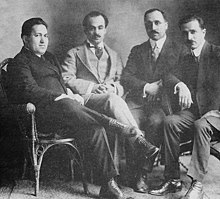
The Mahjar (one of its more literal meanings being "the Arab diaspora") was a literary movement that succeeded the Nahda movement. It was started by Christian Arabic-speaking writers who had emigrated to America from Lebanon, Syria and Palestine at the turn of the 20th century.[145] The writers of the Mahjar movement were stimulated by their personal encounter with the Western world and participated in the renewal of Arabic literature, hence their proponents referred to as writers of the "late Nahda".[146]
The Pen League was the first Arabic-language literary society in North America, formed initially by Syrians Nasib Arida and Abd al-Masih Haddad. Members of the Pen League included: Kahlil Gibran, Elia Abu Madi, Mikhail Naimy, and Ameen Rihani.[147] Eight out of the ten members were Greek Orthodox and two were Maronite Christians.[148] The league dissolved following Gibran's death in 1931 and Mikhail Naimy's return to Lebanon in 1932.[149] Naimy was made famous internationally for his spiritual writings, most notably The Book of Mirdad.
Notable Arab Christians
Notable diaspora figures include Swiss businessman of Lebanese Greek Orthodox descent Nicolas Hayek, and Mexican business magnate of Maronite descent, Carlos Slim. From 2010 to 2013, Slim was ranked as the richest person in the world by the Forbes magazine.[150] Figures in entertainment include actors Omar Sharif (Melkite-born), Salma Hayek, Tony Shalhoub, Vince Vaughn, Danny Thomas, Oscar award winner F. Murray Abraham and film director Youssef Chahine. Figures in academics include plant biologist Joanne Chory, scholar Nassim Nicholas Taleb,[151] cardiac and vascular surgeon Michael DeBakey,[152] inventor of the iPod and co-inventor of the iPhone Tony Fadell,[153] mathematician Michael Atiyah,[154] professor Charles Elachi, intellectual Edward Said, and Nobel Prize winner in Chemistry Elias James Corey[155] and Nobel Prize winner in Physiology or Medicine Peter Medawar.[156][157] Other notables include legendary White House reporter Helen Thomas, activist and presidential candidate Ralph Nader, judge Rosemary Barkett,[158] and US governor and academic administrator Mitch Daniels.
Identity
Denominations
Arab Christians mainly belong to the Greek Orthodox Church of Jerusalem, Greek Orthodox Church of Antioch, Melkite Greek Catholic Church, Maronite Church, and Oriental Orthodox Churches, though some are also members of other churches, including the Catholic Latin Church and Protestant Churches, such as the Lutheran, Anglican, and Reformed traditions.[159]
Self-identification

The issue of self-identification arises regarding specific Christian communities across the Arab world. A significant proportion of Maronites claim descent from the Phoenicians, whilst a significant proportion of Copts claim that they descend from the Ancient Egyptians.[218][219]
Arab
The designation "Greek" in the Greek Orthodox Church and Melkite Greek Catholic Church refers to the use of Koine Greek in liturgy, used today alongside Arabic. As a result, the Greek dominated clergy was commonplace serving the Arabic speaking Christians, the majority who couldn't speak Greek. Some viewed Greek rule as cultural imperialism and demanded emancipation from Greek control, as well as the abolishment of the centralized structure of the institution via Arab inclusion in decision-making processes.[220]

The struggle for the Arabization of the Eastern Orthodox Church against the Greek clerical hegemony in Palestine led Orthodox Christian intellectuals to rebel against the Church's Greek dominated hierarchy. The rebellion was divided between those who sought a common Ottoman cause against European intrusions and those who identified with Arab nationalism against pan-Turkic (Ottoman) nationalism.[221] Its main advocates were well known community leaders and writers in Palestine, such as Ya'qub Farraj, Khalil al-Sakakini, Yusuf al-Bandak (publisher of Sawtal-Sha'b) and cousins Yousef and Issa El-Issa (founders of Falastin). The cousins were among the first to elucidate the Arab struggle against the Greek clerical hegemony of the Church of Jerusalem. Both Sakakini and El-Issa argued that the Palestinian and the Syrian (Antiochian) community constituted an oppressed majority, controlled and manipulated by a minority Greek clergy.[222]
There have been numerous disputes between the Arab and the Greek leadership of the church in Jerusalem from the Mandate onwards.[223][224] Jordan encouraged the Greeks to open the Brotherhood to Arab members of the community between 1948 and 1967 when the West Bank was under Jordanian rule.[223] Land and political disputes have been common since 1967, with the Greek priests portrayed as collaborators with Israel. Land disputes include the sale of St. John's property in the Christian quarter, the transfer of fifty dunams near Mar Elias Monastery, and the sale of two hotels and twenty-seven stores on Omar Bin Al-Khattab square near the Church of the Holy Sepulchre.[223] A dispute between the Palestinian Authority and the Greek Patriarch Irenaios led to the Patriarch being dismissed and demoted because of accusations of a real estate deal with Israel. It was later ruled uncanonical by Patriarch Bartholomew.[225]
Rūm

The homeland of the Antiochian Greek Christians, known as the Diocese of the East, was one of the major commercial, agricultural, religious, and intellectual areas of the Roman Empire, and its strategic location facing the Persian Sassanid Empire gave it exceptional military importance.[226] They are either members of the Greek Orthodox Church of Antioch or the Melkite Greek Catholic Church, and they have ancient roots in the Levant; more specifically, the territories of Syria, Lebanon, Jordan and Hatay, which includes the city of Antakya (ancient Antioch). Antiochian Greeks constitute a multi-national group of people and thus construct their identity in relation to specific historical moments. Analyzing cultural identity as a conscious construction is more helpful than a simple labelling of ethnicity, thus the identity is assumed to accentuate the separate origin unique to the Christian Rūm (literally "Eastern Romans") of the Levant.[227] Some members of the community also call themselves Melkite, which means "monarchists" or "supporters of the emperor" (a reference to their past allegiance to Macedonian and Roman imperial rule) although in the modern era, that term tends to be more commonly used by followers of the Melkite Greek Catholic Church.[228]
The Orthodox Christian congregation was included in an ethno-religious community, Rum Millet ("Roman nation"), during the Ottoman Empire. Its name was derived from the former Eastern Roman (Byzantine) subjects of the Ottoman Empire, but all Orthodox Greeks, Bulgarians, Albanians, Aromanians, Megleno-Romanians and Serbs, as well as Georgians and Middle Eastern Christians, were considered part of the same millet in spite of their differences in ethnicity and language. Belonging to this Orthodox commonwealth became more important to the common people than their ethnic origins.[229]
Chaldean

The former Patriarch of the Chaldean Church, Emmanuel III Delly, made the following comment in a 2006 interview:
"Any Chaldean who calls himself an Assyrian is a traitor and any Assyrian who calls himself Chaldean is a traitor."[230]
The Chaldean Church, which had been part of the Nestorian Church, or Church of the East, until 1552–3, began in earnest to distance itself from the Nestorians who were now seen as the 'uncouth Assyrians'. During this period, many Chaldeans began identifying themselves solely by their religious community, and later as Iraqis, Iraqi Christians, or Arab Christians, rather than with the Assyrian community as a whole. The first split for the two groups came in 431, when they broke away from what was to become the Catholic Church over a theological dispute.[231] The reverberation of religious animosity between these communities still continues today, a testament to the machinations of power politics in the nation-building of the Middle East.[232] The Iraqi Chaldeans positioned themselves deliberately as a religious group within the Arab Iraqi nation. The Arab identity of the state was not only acceptable to them, but was even staunchly endorsed. The Arab nationalism they supported did not discriminate according to religion and was therefore also acceptable to them.[217] Today, due to both forced and accepted Arabization, many Chaldeans identify themselves situationally as Arabs.[232]
The Assyrians/Syriacs (including Chaldeans) form the majority of Christians in Iraq, northeast Syria, south-east Turkey and north-west Iran. They are specifically defined as non-Arab indigenous ethnic group, including by the governments of Iraq, Lebanon, Iran, Syria, Israel, and Turkey.[233]
Culture

Christianity in the Middle East represents a large part of the region's diverse culture mosaic.[234] The region includes the oldest Christian monuments in addition to the liturgy and hymns that have spread since the second century AD throughout the region.[235] Christian Arabs celebrate various holy days, including the Feast of the Cross, Eid il-Burbara, Christmas, the Feast of St. George, and the Feast of the Prophet Elijah. In Christian traditions, Sergius and Bacchus are considered the patron saints of Arabs.[236]
There are no major cultural differences between Christian Arabs and the general Arab environment.[237] Some differences arise from religious differences, for example, customs and traditions related to marriage or burial. Also, in social events in which the participants are Christians, alcoholic beverages are often served (apart from those denominations that encourage teetotalism), unlike what is prevalent in most Arab societies because Islamic law forbids strong drink.[238] Christian cuisine is similar to other Middle Eastern cuisines; unlike in Jewish cuisine and Islamic cuisines in the region, pork is allowed among Arab Christians, though it is not widely consumed. Male circumcision is near-universal among Christian Arabs,[239][240] and they practice it shortly after birth as part of a rite of passage,[241] though the practice of circumcision was dropped in the New Testament, meaning that the mainstream Churches do not oblige their followers to do so.[242] In some Eastern Christian denominations, such as Coptic Christianity,[243] male circumcision is an established practice, and require that their male members undergo circumcision shortly after birth as part of a rite of passage.[244][245]
Demographics
Arab Christian communities can be found throughout the Arab world.
Algeriaedit

Christianity came to Algeria in the Roman era, and declined after the arrival of Islam in the 7th century. A notable Berber Christian of Algeria was Saint Augustine and his mother Saint Monica, important saints in Christianity. Prior to independence from France in 1962, Algeria was home to 1.4 million pieds-noirs (ethnic Europeans who were mostly Catholic).[246] Arguably, many more Maghrebi Christians live in France than in North Africa, due to the exodus of the pieds-noirs in the 1960s.
In 2009, the percentage of Christians in Algeria was less than 2%. In this same survey, the United Nations counted 100,000 Catholics and 45,000 Protestants in the country.[247] A 2015 study estimates 380,000 Muslims converted to Christianity in Algeria.[248] Conversions have been most common in the region of Kabylie.[249] Charles de Foucauld was renowned for his missions in Algeria among Muslims, including Arabs.
Bahrainedit
Native Christians who hold Bahraini citizenship number approximately 1,000.[250] The majority of Christians are originally from Iraq, Palestine and Jordan, with a small minority having lived in Bahrain for many centuries; the majority have been living as Bahraini citizens for less than a century. There are also smaller numbers of native Christians who originally hail from Lebanon, Syria, and India. The majority of Christian Bahraini citizens tend to be Orthodox Christians, with the largest church by membership being the Greek Orthodox Church. They enjoy many equal religious and social freedoms. Bahrain has Christian members in the Bahraini government.
Zdroj:https://en.wikipedia.org?pojem=Arab_ChristianText je dostupný za podmienok Creative Commons Attribution/Share-Alike License 3.0 Unported; prípadne za ďalších podmienok. Podrobnejšie informácie nájdete na stránke Podmienky použitia.
Antropológia
Aplikované vedy
Bibliometria
Dejiny vedy
Encyklopédie
Filozofia vedy
Forenzné vedy
Humanitné vedy
Knižničná veda
Kryogenika
Kryptológia
Kulturológia
Literárna veda
Medzidisciplinárne oblasti
Metódy kvantitatívnej analýzy
Metavedy
Metodika
Text je dostupný za podmienok Creative
Commons Attribution/Share-Alike License 3.0 Unported; prípadne za ďalších
podmienok.
Podrobnejšie informácie nájdete na stránke Podmienky
použitia.
www.astronomia.sk | www.biologia.sk | www.botanika.sk | www.dejiny.sk | www.economy.sk | www.elektrotechnika.sk | www.estetika.sk | www.farmakologia.sk | www.filozofia.sk | Fyzika | www.futurologia.sk | www.genetika.sk | www.chemia.sk | www.lingvistika.sk | www.politologia.sk | www.psychologia.sk | www.sexuologia.sk | www.sociologia.sk | www.veda.sk I www.zoologia.sk



